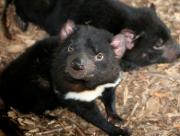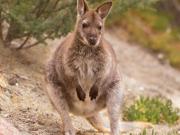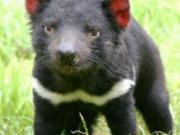Wildlife Attaraction in Tasmania
Tasmania is full of wildlife, yet many visitors will easily miss it. Due to the dense shrubbery and mostly nocturnal nature of many of the native animals, walkers will need to keep their eyes peeled to catch sight of some of the cleverer creatures. Unfortunately, the prolific nature of the wildlife is evident by the amount of roadkill you'll come across on your travels. Motorists can help prevent this by slowing down at night and taking heed of wildlife warning signs.
The trick to spotting wildlife in Tassie is to become one with nature - walk quietly, slowly and use your ears and eyes to explore. The snap of a twig or a swish of scrub may be a wallaby nearby, tracks in the sand or dirt may indicate recently passed birds or animals, a splash in a creek or waterhole could be a platypus or some feathers and bones may be the remains of a Tasmanian devil's dinner. Take a walk at dusk with a torch to spot wombats, possums and wallabies. Mt William, Freycinet and the Narawntapu Parks are good for spotlight walks, while Mt William is also a refuge for forester kangaroos, the island's largest marsupials (they graze at dawn and dusk).
Specialist wildlife attractions tours are widely available and are highly recommended as they will provide you with the best opportunity to get camera-close to devils, wombats or quolls. Latrobe, in the northwest, is one of the best places to view platypus in the wild and the local Landcare group conducts tours.
The little echidna, the platypus's closest relative and the world's only other egg-laying mammal, can often be seen waddling through the bush or on the side of the road. Be careful if you see one on the road as it certainly won't hurry to get out of your way. This curious little creature is about the size of a small football and has spines, fur, a long beak, a sticky tongue and digging claws.
Birdlife also abounds with sea eagles who hover over the coastal cliffs, shearwaters (who make an annual trip north to the arctic circle and, amazingly, return almost to the day each year to nest in the same burrow!) and many rare and colourful parrots. You'll find rare swift parrots, orange-bellied parrots (particularly in Melaleuca in the Southwest wilderness), ocean-going albatrosses, fairy penguins toddling up beaches and pink robins darting about the rainforest floor. In the Tamar Island wetlands there are marsh birds, native ducks, black swans, herons, cormorants and pelicans.
There is also a rich marine life beneath the waves, including dolphins, fur seals, whales. Experience scuba diving in Tasmania and open up a whole new world.
One animal you probably won't come across is the thylacine, or Tasmanian tiger. The last one supposedly died in captivity in 1936 but many people have claimed to have spotted one since and some still believe it roams in the wilderness. Have the camera ready and you could become famous!




